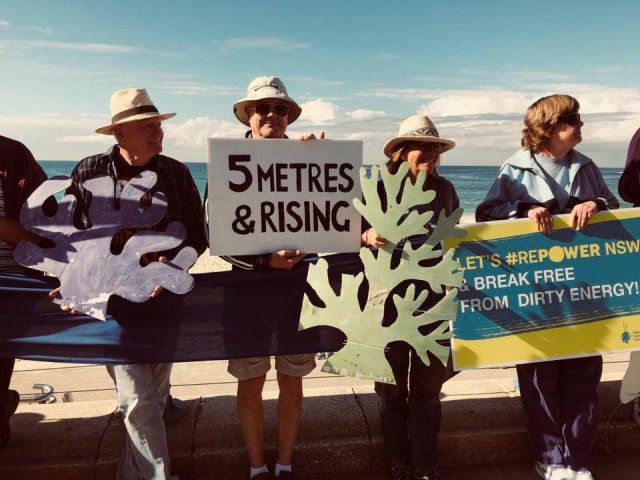
Around 60 people unfurled a long blue ribbon on May 19 at Coogee beach five metres from the coast line. The action symbolised future seal level rises and the erosion of Coogee's beautiful coast line if state and federal governments continue to support coal and gas production over renewable energy.
The “Line in the Sand” action was part of the Repower NSW campaign, which, in the lead up to the state elections next March, is calling on the government to phase out coal-fired power stations and ensure a just transition to 100% clean energy by 2030.
Repower Coogee volunteer Dr Oliver Kunz is a post-doctoral researcher at the University of NSW (UNSW) focusing on photovoltaic and renewable energy engineering.
He said: “Getting to 100% clean energy is not only possible, it is also Australia’s most affordable energy pathway. Australia is one of the largest per capita greenhouse gas emitters, but it has a wealth of renewable resources which it can harness to take long-overdue climate action.”
The Member for Coogee is Liberal Bruce Notley-Smith, who sits perilously in a very marginal seat. Repower NSW volunteer organiser, Carrie Tsai, said Repower Coogee will door knock the local area in the lead up to the election with the message that we need a “firm commitment from the government to rapidly and fairly transition away from fossil fuels to 100% clean energy by 2030”.
A Repower Coogee press release noted that research from the UNSW Climate Research Department shows that 120,000 years ago, global temperatures were similar to today. Back then, “sea levels were 5–10 metres higher than now. Ocean levels are not as high today because there is a centuries-long lag before global temperatures eventually affect our rising oceans”.
Repower Coogee volunteer Dorothee Babeck said: “While the inertia of climate change means we have already locked in significant amounts of sea level rise, the rate and extent of sea level rise depends on whether we take rapid action to reduce our greenhouse gas emissions.
“More than 100 million people globally live within one metre of the high-level mark, whereas business-as-usual action on climate change could cause multi-metre sea-level rise by the end of the century. To avoid disastrous social, economic and environmental consequences far more urgent and significant emissions reduction would be required than the world, and particularly Australia, has currently committed to” Babeck said.
Endeavour Fellow at the UNSW studying climate justice Alex Lenferna said: “Australia is failing to take adequate action, falling far behind not only countries like New Zealand and Norway, but also close to 50 of the world’s least developed countries who have all committed to 100% clean energy.”
Research from the Nature Conservation Council has shown that transitioning to 100% clean energy for NSW could create 22,000 full-time jobs each year, secure $25 billion of investment for regional NSW and stop 60 million tonnes of carbon pollution each year.
Repower NSW coordinator Jacqui Mumford highlighted the importance of sharing those benefits equitably, calling for a just transition that helps workers transition to a low carbon economy and ensures everyone has equitable access to clean and renewable energy.
[For more details about the Repower NSW campaign and the report on how NSW can transition to 100% clean energy, Repowering our Regions, visit nature.org.au]